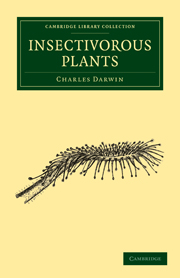Book contents
- Frontmatter
- Contents
- CHAPTER I DROSERA ROTUNDIFOLIA, OR THE COMMON SUN-DEW
- CHAPTER II THE MOVEMENTS OF THE TENTACLES FROM THE CONTACT OF SOLID BODIES
- CHAPTER III AGGREGATION OF THE PROTOPLASM WITHIN THE CELLS OF THE TENTACLES
- CHAPTER IV THE EFFECTS OF HEAT ON THE LEAVES
- CHAPTER V THE EFFECTS OF NON-NITROGENOUS AND NITROGENOUS ORGANIC FLUIDS ON THE LEAVES
- CHAPTER VI THE DIGESTIVE POWER OF THE SECRETION OF DEOSERA
- CHAPTER VII THE EFFECTS OF SALTS OF AMMONIA
- CHAPTER VIII THE EFFECTS OF VARIOUS OTHER SALTS, AND ACIDS, ON THE LEAVES
- CHAPTER IX THE EFFECTS OF CERTAIN ALKALOID POISONS, OTHER SUBSTANCES AND VAPOURS
- CHAPTER X ON THE SENSITIVENESS OF THE LEAVES, AND ON THE LINES OF TRANSMISSION OF THE MOTOR IMPULSE
- CHAPTER XI RECAPITULATION OF THE CHIEF OBSERVATIONS ON DROSERA ROTUNDIFOLIA
- CHAPTER XII ON THE STRUCTURE AND MOVEMENTS OF SOME OTHER SPECIES OF DROSERA
- CHAPTER XIII DIONÆA MUSCIPULA
- CHAPTER XIV ALDROVANDA VESICULOSA
- CHAPTER XV DROSOPHYLLUM — RORIDULA — BYBLIS — GLANDULAR HAIRS OF OTHER PLANTS — CONCLUDING REMARKS ON THE DROSERACEÆ
- CHAPTER XVI PINGUICULA
- CHAPTER XVII UTRICULARIA
- CHAPTER XVIII UTRICULARIA (continued)
- ERRATA
- INDEX
CHAPTER III - AGGREGATION OF THE PROTOPLASM WITHIN THE CELLS OF THE TENTACLES
Published online by Cambridge University Press: 29 August 2010
- Frontmatter
- Contents
- CHAPTER I DROSERA ROTUNDIFOLIA, OR THE COMMON SUN-DEW
- CHAPTER II THE MOVEMENTS OF THE TENTACLES FROM THE CONTACT OF SOLID BODIES
- CHAPTER III AGGREGATION OF THE PROTOPLASM WITHIN THE CELLS OF THE TENTACLES
- CHAPTER IV THE EFFECTS OF HEAT ON THE LEAVES
- CHAPTER V THE EFFECTS OF NON-NITROGENOUS AND NITROGENOUS ORGANIC FLUIDS ON THE LEAVES
- CHAPTER VI THE DIGESTIVE POWER OF THE SECRETION OF DEOSERA
- CHAPTER VII THE EFFECTS OF SALTS OF AMMONIA
- CHAPTER VIII THE EFFECTS OF VARIOUS OTHER SALTS, AND ACIDS, ON THE LEAVES
- CHAPTER IX THE EFFECTS OF CERTAIN ALKALOID POISONS, OTHER SUBSTANCES AND VAPOURS
- CHAPTER X ON THE SENSITIVENESS OF THE LEAVES, AND ON THE LINES OF TRANSMISSION OF THE MOTOR IMPULSE
- CHAPTER XI RECAPITULATION OF THE CHIEF OBSERVATIONS ON DROSERA ROTUNDIFOLIA
- CHAPTER XII ON THE STRUCTURE AND MOVEMENTS OF SOME OTHER SPECIES OF DROSERA
- CHAPTER XIII DIONÆA MUSCIPULA
- CHAPTER XIV ALDROVANDA VESICULOSA
- CHAPTER XV DROSOPHYLLUM — RORIDULA — BYBLIS — GLANDULAR HAIRS OF OTHER PLANTS — CONCLUDING REMARKS ON THE DROSERACEÆ
- CHAPTER XVI PINGUICULA
- CHAPTER XVII UTRICULARIA
- CHAPTER XVIII UTRICULARIA (continued)
- ERRATA
- INDEX
Summary
I will here interrupt my account of the movements of the leaves, and describe the phenomenon of aggregation, to which subject I have already alluded. If the tentacles of a young, yet fully matured leaf, that has never been excited or become inflected, be examined, the cells forming the pedicels are seen to be filled with homogeneous, purple fluid. The walls are lined by a layer of colourless, circulating protoplasm; but this can be seen with much greater distinctness after the process of aggregation has been partly effected than before. The purple fluid which exudes from a crushed tentacle is somewhat coherent, and does not mingle with the surrounding water; it contains much flocculent or granular matter. But this matter may have been generated by the cells having been crushed; some degree of aggregation having been thus almost instantly caused.
If a tentacle is examined some hours after the gland has been excited by repeated touches, or by an inorganic or organic particle placed on it, or by the absorption of certain fluids, it presents a wholly changed appearance. The cells, instead of being filled with homogeneous purple fluid, now contain variously shaped masses of purple matter, suspended in a colourless or almost colourless fluid. The change is so conspicuous that it is visible through a weak lens, and even sometimes by the naked eye; the tentacles now have a mottled appearance, so that one thus affected can be picked out with ease from all the others.
- Type
- Chapter
- Information
- Insectivorous Plants , pp. 38 - 65Publisher: Cambridge University PressPrint publication year: 2009First published in: 1875



